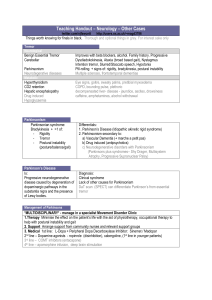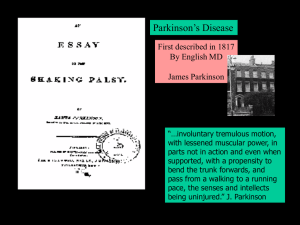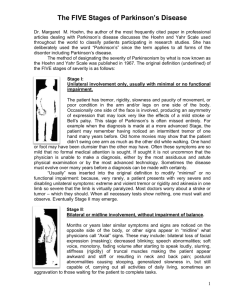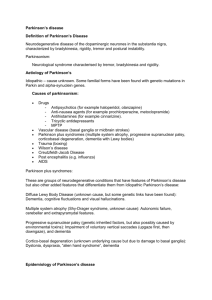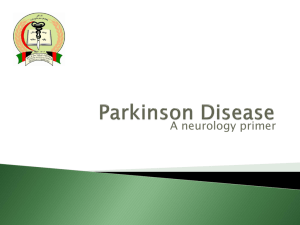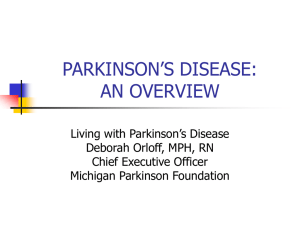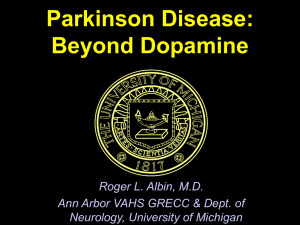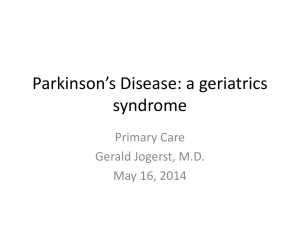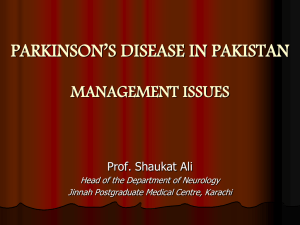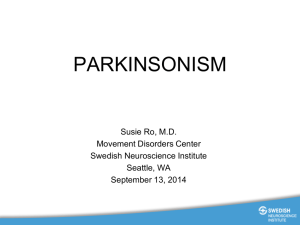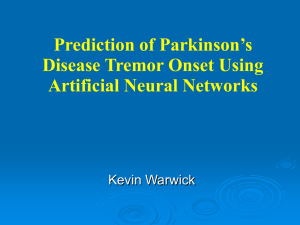Movement Disorders for GP Registrars
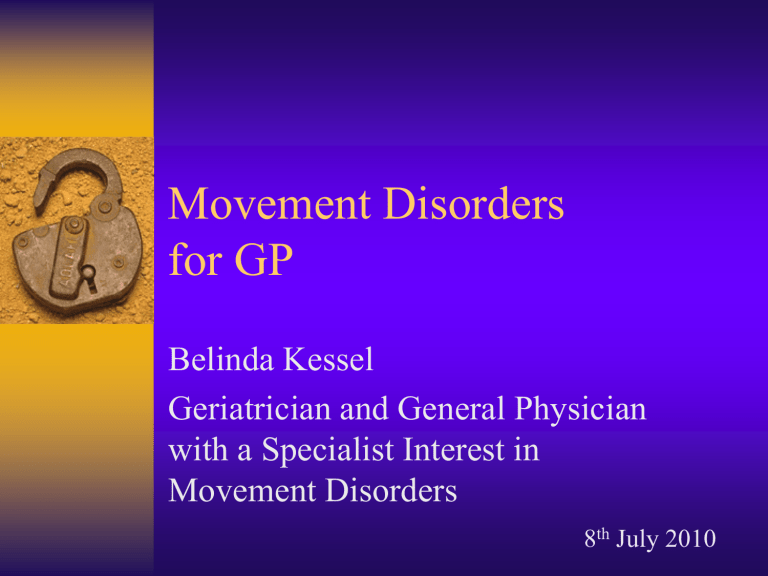
Movement Disorders for GP
Belinda Kessel
Geriatrician and General Physician with a Specialist Interest in
Movement Disorders
8 th July 2010
Case history
67 year old left handed gentleman with a right sided tremor
Tremor present for 10 months and occurs at rest and posture (driving, holding golf club)
Wife noticed decreased arm movements when walking but gait not shufffly
No changes in speech, swallow or memory but long standing constipation
Examination
Reduction in facial expression
Resting tremor on right
Mild increase in tone with cogwheeling on right
Mild bradykinesia with decrease arm swing on right.
Diagnosis and management
Idiopathic right sided tremulous Parkinson’s disease
Started on a dopamine agonist and titrated
Information given on PD and drug side-effects
Told to inform DVLA
Follow up 2/12 with PD nurse specialist
Further referrals to physiotherapy, OT and SALT as required including invite to new PD patient information course
Movement Disorders…
Shakes/tremors
Abnormal movements such as tics, chorea, dystonias
Bradykinesia (slow movement)
Not falls alone- refer Falls Clinic
Paradoxically if known movement disorder no need to send to falls clinic as well
Movement Disorders…
Parkinson’s Disease
Cardinal Signs of Parkinson’s;
Bradykinesia
Rigidity
Tremor
Postural Instability
Movement Disorders…
Parkinson’s Disease
Essential Tremor
Differentiation of ET and PD
Features of
Tremor
Essential tremor
Parkinson’s disease
Symmetry
When occurs
Other symptoms
Family History
Helps tremor
Length of time
Symmetrical Asymmetrical
On action At rest none Rigidity bradykinesia
Not usually yes
Alcohol
Over 5 years
Not usually
6-24 months
Movement Disorders…
Parkinson’s Disease
Essential Tremor
Cerebrovascular Parkinsonism
Drug Induced Parkinsonism
Parkinson Plus Syndromes
– Multi System Atrophy (MSA)
– Progressive Supranuclear Palsy (PSP)
– Lewy Body Dementia (LBD)
Others
Drug Induced Tremor
Salbutamol
Lithium
Sodium Valproate
Drug Induced Parkinsonism
Anti-dopaminergics
Anti-emetics
– Stemetil (Prochlorperazine)
– Maxalon (Metoclopramide)
Anti-psychotics
– Typicals eg Haloperidol and Chlorpromazine
– Atypicals eg Risperidone and Olanzepine
– Don’t forget depot injections
Anti Dementia drugs (anti cholinesterase inhibitors)
– Rivastigmine, Donepezil
Drug Induced Parkinsonism
It can take up to 6 months for Parkinsonian drugs to wash out the system
Dilemmas
Do they have underlying Parkinson’s
Disease worsened by the drug
Can the offending drug be stopped
Do they need urgent treatment for their movement disorder
Referrals
Rarely ‘urgent’
Send drug treatment naïve
– May be wrong diagnosis
– May not be on best drug
Full drug history
Referrals
Determined by age
•
< 65years to the neurologists
• >/= 65 years to me (Belinda Kessel)
Consider alternative diagnosis to PD
Consider what drugs they are on
Movement Disorder Service
Seen by consultant -/+ registrar on first visit
Tests may be arranged eg MRI brain scan
Often diagnosis on first visit
– Given lots of information eg leaflets
– Website/telephone number of PD society if appropriate
Letter to GP and patient gets copy
Movement Disorder Service
Referred as appropriate to
– Speech and language therapists
• For assessment and therapy
• For PD awareness course
– Physiotherapist
– Occupational therapist
– PD community support worker
– Parkinson’s Disease nurse specialist for first follow up (Lynne Waller PDNS)
Role of Parkinson’s Disease
Nurse Specialist
Information for patient
Titration of drugs/monitoring of side effects
Monitoring symptoms both motor and non-motor
Referral to appropriate therapist
Advice for patient, carers and GP’s in clinic or by phone
Liaison between hospital staff and patient
Unable to do home visits
Diagnosing PD
Still a clinical diagnosis
Levo-dopa or apomorphine challenge tests not recommended
Trial of medication still good indicator
Brain scans;CT or MRI are to check for other causes eg stroke disease
Uses of DaTSCAN
TM
(
123
I-FP-CIT SPECT)
Shows dopamine uptake in basal ganglia
Differentiate PD from;
Essential Tremor
Dystonic Tremor
Drug induced Tremor and Parkinsonism
Cerebrovascular Parkinsonism
Lewy Body Dementia or Alzheimers
Poor response to Parkinson treatment
DAT Scan
Parkinson Plus Syndromes
Multi System Atrophy
(Shy Drager Syndrome)
Progressive Supranuclar Palsy
(Steele Richardson Olszewski disease)
Lewy Body Dementia
Red Flags for Parkinson Plus
Presence of early instability and falls
Pyramidal or cerebellar signs
Downgaze palsy
Early autonomic failure
Early confusion/hallucinations
Poor response to L-dopa
Non Motor Symptoms In PD
These may often predate the onset and therefore the diagnosis of motor symptoms by 4-6 years
Non Motor Symptoms in PD
Anosmia
Restless Legs
Syndrome
Sleep disturbance
Urinary problems
Bowel problems
Weight loss
Speech/swallow problems
Dizzyness on standing
Memory Problems
Apathy
Hallucination/ nightmares
Depression
Excessive sweating
Double Vision
When to start Treatment and
What?
Preferably not before seeing the specialist
If possible we start a Dopamine Agonist
Other options are;
L-Dopa +/- COMT
MAO inhibitor
NB no evidence yet of any drug being neuroprotective
1.
Drug Therapy
Anticholinergics - Benhexhol
- Orphenadrine
S.E.; anticholinergic increase dystonias neuropsychiatric
2.
Amantidine - mild anti-Parkinson effect
Useful in dyskinetic patients
Rarely can cause confusion
3.
Leva-Dopa
Madopar=l-dopa and benserazide
Sinemet=l-dopa and carbidopa
Different preparations
- capsules
- dispersible tablets
- controlled release
4.
Dopamine agonists
Old ; Pergolide, Lisuride, Bromocriptine
Cabergoline
New ; Pramipexole (Mirapexin),
Ropinerole (Requip)
Rotigotine patch (Neupro)
Apomorphine - s/c by injection or infusion
Dopamine Agonist side-effects
Peripheral oedema
Postural hypotension
Confusion and hallucinations
Nausea (use Domperidone)
Lung and cardiac valve fibrosis (ergot)
Somnalence and SOOS
Dopamine Dysregulation Syndrome and
Impulse Control Disorders
Information sheet of Dopamine Agonists
The following drugs are commonly used in patients with Parkinson’s disease and are classed as Dopamine Agonists. They are
Ropinirole (Requip ®), Cabergoline (Cabaser ®), Pramipexole (Mirapexin ®). There is also a transdermal patch called Rotigotine
(Neupro
®). These drugs can be useful to help the tremor and the slowness seen in Parkinson’s patients. Occasionally side effects occur, the most common one being nausea on first starting the drug, so often you will be given an anti-nausea drug called
Domperidone (Motilium
®) to prevent this.
Other side-effects sometimes seen are swelling of the ankles , dizziness on standing due to blood pressure dropping and also occasionally some confusion or hallucinations .
Sleepiness can occur and it is advisable when first starting this drug and during the period of increasing the dose (titration period) that if you drive a car you should always be with another person, in case the sleepiness comes on whilst driving.
A very rare side-effect with Cabergoline is fibrosis of the lungs and narrowing or leaking of the heart valves. This would give increasing shortness of breath over a period of time. If you get shortness of breath whilst taking the drug let your GP or Specialist know but don’t stop the drug immediately as it is much more likely that the breathing problem is due to other causes not related to the
Parkinson treatment. We now monitor by yearly chest X-rays and heart scans (echocardiograms).
The Rotigotine patch can occasionally cause a local skin reaction (1 in 20).
Very rarely with Parkinson drugs people taking them do normal things more excessively than usual , for example; eating, gambling, shopping, hoarding objects or having sex. Do let the doctor/nurse know if you or your partner thinks this is happening to you.
Most of the side-effects are mild and it is not necessary to stop the drug. However, if you feel the side-effects are outweighing the benefit of the drug, then we would consider stopping the drug. It is best to try and contact either Anne Martin or the doctor who prescribed the drug to discuss this, as it is usually not advisable to stop the drug suddenly, unless you have just started it. Often the symptoms go away if the dose of the drug is decreased, rather than completely stopping the drug. You may not notice any difference in your movements/tremor on starting the new drug but this may be because the dose to start with is small and is gradually built up.
Therefore please continue taking it. If you need further information, please do not hesitate to get in touch with Lynne Waller, the
Parkinson Nurse , or your Consultant through their secretary, whose numbers are available via the hospital switchboard ( 01689
863000 ).
If you do not understand the above information or have concerns then do not start the new drug until you have further discussed them with either Lynne Waller or your Specialist.
5.
COMT inhibitors - Entacapone (Comtess)
Use in conjunction with L-dopa
Smoothes out fluctuations
S.E. - neuropsychiatric
- increases dyskinesias
Commonly used in conjunction with Sinemet
Plus in the form of Stalevo
6.
Selegiline, Rasagiline - MAO-B Inhibitors
NB care with tricyclics as risk of Seratonin
Syndrome
Treatment-Related Complications
1.
2.
3.
Fluctuations
Dyskinesias
Confusion or hallucinations
Management of complications
Fluctuation and dyskinesias
– Manipulation of the drugs
– New routes of administration
– Surgery
New routes of administration
Apomorphine pump (Apo-go)
Duodopa therapy – continuous
L-dopa infusion into jejunum
Surgical Treatment
Lesioning
Deep Brain Stimulation (DBS)
Deep Brain Stimulators
Deep Brain Stimulators
Management of complications
Confusion and hallucinations
Psychiatric Side-effects
-’last in, first out principle’
- Order of stopping;
- anticholinergics
- selegiline
- amantidine
- dopamine agonists
- MAO-I
- L-dopa
Old Drugs – New Indication
Anticholinesterase Inhibitors – LBD, apathy
– Rivastigmine
– Donepezil
Atypical antipsychotics – hallucinations, agitation, dementia
– Quetiapine
– Clozapine (Psychiatrists only)
